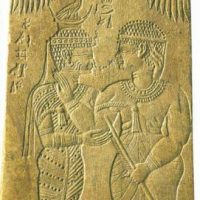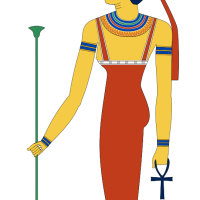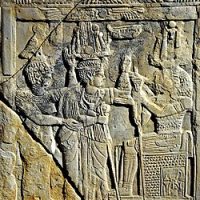Amesami : The Protective Moon Goddess of the Kushite Kingdom
Listen
At a glance
| Description | |
|---|---|
| Origin | Kushite Mythology |
| Classification | Gods |
| Family Members | Apedemak (Husband) |
| Region | Sudan |
| Associated With | Moon, Fertility, Cycles |
Amesami
Introduction
Amesami, also known as Amesemi in some transliterations, is a revered goddess from Kushite mythology whose worship flourished in the ancient Nubian Kingdom of Kush, located in present-day Sudan. She is celebrated primarily as a protective deity and lunar goddess, deeply embedded in the spiritual and political identity of the Meroitic period. Her presence in temple reliefs, including those in Naqa and Musawwarat es-Sufra, illustrates her significance in the daily and ceremonial life of the Kushites. As the divine consort of Apedemak, the powerful lion-headed god of war and fertility, Amesami embodied balance, safety, and celestial order.
Her imagery and symbolism reveal a goddess who united the rhythms of the moon with the protective oversight of the divine, contributing to a distinctly Kushite religious aesthetic. Unlike the Egyptian pantheon, where mythic narratives were often richly detailed, Amesami’s identity emerges primarily through her iconography and ritual positioning, making her an essential figure for understanding Nubian spirituality and its localized expression of divine femininity.
Physical Traits
Amesami is instantly recognizable in Kushite art through her elaborate headdress, typically featuring a crescent moon topped by a falcon. This combination conveys her celestial authority and protective vigilance, linking her simultaneously to lunar cycles and the sky-dwelling bird that symbolized divine watchfulness. Her attire is usually depicted as a long robe worn over undergarments, reflecting both dignity and ritual purity in Meroitic artistic conventions.
Kushite artists portrayed Amesami with a corpulent form, a characteristic common in Meroitic representations of women and goddesses. This fuller body shape symbolized vitality, prosperity, and maternal power rather than physical beauty alone. In some reliefs, she appears holding an additional set of hands or beads — an unusual feature that has prompted scholarly interpretations related to extra-sensory protection or ritual symbolism.
Her calm expression, often positioned behind or beside the more aggressive figure of Apedemak, emphasizes her role as a stabilizing cosmic force, complementing martial energy with nurturing celestial guardianship.
Family
Amesami’s most important mythological relationship is her union with Apedemak, the lion-headed warrior god who served as a major protector of the Kingdom of Kush. Their pairing appears prominently in temple reliefs such as those at the Lion Temple of Naqa, where they flank kings in scenes of divine blessing and royal empowerment. This partnership symbolizes a dual balance: Apedemak representing strength, warfare, and masculine force, while Amesami embodies protection, wisdom, and the cyclical rhythm of the moon.
Unlike Egyptian mythology, which presents extensive genealogies, the Kushite tradition focuses less on divine lineage and more on ritual function. As a result, Amesami is not explicitly associated with divine offspring or a broader family tree. Instead, her importance lies in her supportive and complementary role to Apedemak and the Kushite kings, grounding royal authority in both martial might and divine nurturing.
Other names
While Amesami is the most widely accepted version of her name today, variants such as Amesemi appear in early archaeological transliterations of Meroitic texts. The Meroitic script remains only partially deciphered, making definitive alternate names or epithets difficult to confirm. Most proposed variations arise from phonetic interpretation rather than culturally attested titles.
Although she does not have direct equivalents in Egyptian or Greco-Roman mythology, scholars often use comparative mythology to explain her lunar and protective aspects. Thus, Amesami is sometimes loosely aligned with the Greek Selene or Roman Luna, but these parallels are interpretive rather than historical. Similar comparisons exist with African deities such as Yemọja or Nzambici, who embody protective feminine power or lunar symbolism. These comparisons help illustrate her archetype but should not be considered alternate names for the goddess herself.
Powers and Abilities
Amesami’s primary domain is protection, a role that permeates every aspect of her iconography. As a lunar goddess, she embodies cycles, hidden knowledge, fertility, and the calm guidance associated with the night sky. Her crescent-falcon headdress reinforces this celestial authority, suggesting she watches over both the cosmic order and the earthly kingdom.
Her protective role is also political. She is frequently shown standing behind kings or beside Apedemak in scenes of royal blessing, demonstrating her power to safeguard rulers and legitimize their authority. Whether invoked by priests or venerated by ordinary people, Amesami served as a guardian against misfortune, spiritual threats, and instability. Her partnership with Apedemak also implies shared responsibility in safeguarding the military strength and divine balance of the realm.
Modern Day Influence
Although the worship of Amesami faded after the decline of the Kushite Kingdom, her legacy persists in contemporary scholarship and cultural revitalization efforts. Archaeological discoveries at Naqa and Musawwarat es-Sufra continue to highlight her role in Nubian religion, allowing modern audiences to better understand the depth and uniqueness of Kushite spirituality.
In recent years, Amesami has emerged as an emblem of African femininity and celestial symbolism. Artists, historians, and cultural revivalists draw inspiration from her distinctive crescent-falcon imagery, incorporating it into jewelry, illustration, and aesthetic reinterpretations of African myth. As global interest in non-Egyptian African civilizations grows, Amesami is increasingly celebrated as a representative figure of Nubian heritage—one who challenges narrow definitions of ancient goddess archetypes by blending corpulence, protection, and lunar mystery.
Today, she stands as one of the most important female deities of the Kushite pantheon, offering insight into how ancient Nubia expressed divine power, royal legitimacy, and celestial order in ways that were uniquely their own.
Related Images
Source
Wikipedia contributors. (2023). Kushite religion. In Wikipedia, The Free Encyclopedia. Retrieved November 14, 2025, from https://en.wikipedia.org/wiki/Kushite_religion
Wikipedia contributors. (2019). Amesemi. In Wikipedia, The Free Encyclopedia. Retrieved November 14, 2025, from https://en.wikipedia.org/wiki/Amesemi
World History Encyclopedia. (2018, February 25). The Kingdom of Kush. https://worldhistory.org/Kush/
Wikipedia contributors. (2023). Amun. In Wikipedia, The Free Encyclopedia. Retrieved November 14, 2025, from https://en.wikipedia.org/wiki/Amun
Ancient Origins. (n.d.). The Ancient City of Naqa – The Kushite Religious Stronghold. https://www.ancient-origins.net/ancient-places-africa/ancient-city-naqa-kushite-religious-stronghold-00921
Dunham, D. (1955). The Royal Cemeteries of Kush: Volume II. Museum of Fine Arts, Boston.
Welsby, D. A. (1996). The Kingdom of Kush: The Napatan and Meroitic Empires. Markus Wiener Publishers.
Török, L. (2002). The Image of the Ordered World in Ancient Nubian Art. Brill Academic Publishers.
Kendall, T. (1997). Napatan Temples: A Case Study from Gebel Barkal. In Studies in Nubian Archaeology.
Trigger, B. G. (1978). Nubia under the Kushites. In The Cambridge History of Africa (Vol. 2). Cambridge University Press.
Frequently Asked Questions
Who is Amesami in Kushite mythology?
Amesami is a protective lunar goddess from the ancient Kingdom of Kush, known as the consort of the lion-headed god Apedemak.
What does Amesami look like in ancient art?
She is depicted with a crescent-moon headdress topped by a falcon, wearing layered robes and adorned with large-beaded jewelry.
What powers is Amesami believed to possess?
Amesami is associated with protection, lunar cycles, fertility, and the safeguarding of kings and kingdoms.
Where was Amesami worshipped?
She appears prominently in temples at Naqa and Musawwarat es-Sufra during the Meroitic period of Kush.
Is Amesami related to Egyptian moon goddesses?
She is not directly related, but scholars sometimes compare her role to lunar deities like Selene or Luna for thematic context.








